The Microsoft Surface Laptop 4 15-Inch Review: Refreshing Ryzen
by Brett Howse on May 6, 2021 8:00 AM ESTGraphics Performance
One major point of differentiation with the previous generation Surface Laptop 3 was Microsoft partnering with AMD to offer a "semi-custom" design. For the APUs that went into the Surface laptops, Microsoft got chips with an additional graphics unit (CU) enabled for both the Ryzen 5 and Ryzen 7 models, resulting in nine and eleven total graphics units, respectively.
With Renoir, AMD decided to cut back on the total graphics hardware for their integrated Vega GPU, and make up the difference with higher frequencies thanks to the better 7 nm process. As such, a normal 15-Watt Ryzen 5 model will offer six graphics units, and Ryzen 7 offers eight. The semi-custom Ryzen Microsoft Surface Editions do get access to an additional graphics unit on the Ryzen 5 models, bumping it up to seven total, but the Ryzen 7 4980U is not so lucky, and makes do with the same eight compute units as all other Ryzen 7 4000 series processors. Any performance uplifts from the normal Ryzen 7 will be due to the higher maximum frequency, boosted to 1950 MHz on the 4980U, which is 200 MHz higher than the Ryzen 7 4800U, and 350 MHz higher than the Ryzen 7 4700U.
| Surface Laptop Processors | |||||
| CPU | Intel Core i5-1145G7 | Intel Core i7-1185G7 | AMD Ryzen 5 4680U | AMD Ryzen 7 4980U | |
| GPU Design | Intel Iris Xe | Intel Iris Xe | AMD Vega | AMD Vega | |
| GPU Size | 80 Execution Units | 96 Execution Units | 7 Compute Units | 8 Compute Units | |
| Max Boost Frequency | 1300 MHz | 1350 MHz | 1500 MHz | 1950 Mhz | |
| Process | Intel 10nm SuperFin | Intel 10nm SuperFin | TSMC 7nm | TSMC 7nm | |
To see how the Surface Laptop 4 performs in gaming, it was run through our standard laptop graphics suite, which includes a couple of synthetic tests, as well as some actual gaming results. For the most part, the comparison devices are either AMD or Intel with integrated graphics. The MSI Prestige, highlighted in blue, features the latest Intel Xe graphics thanks to its Tiger Lake internals. The Surface Book 3 is included just to get a feel for where the integrated results are against a device with a decent dGPU, as the Surface Book 3 features the NVIDIA GTX 1660 Ti graphics adapter.
3DMark
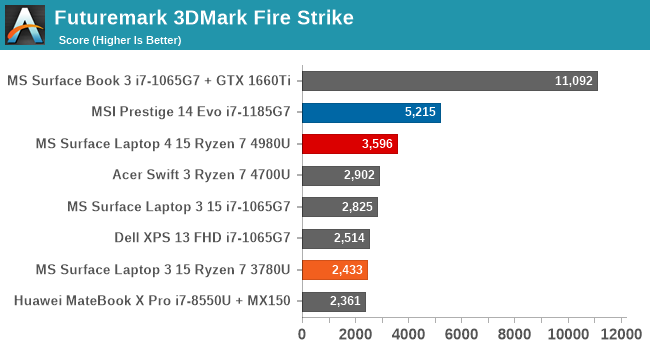

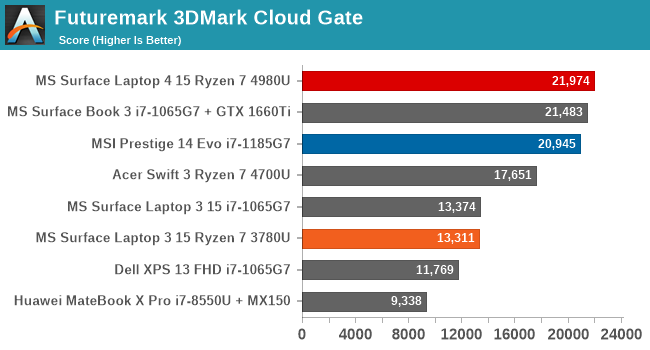

As a purely synthetic test, 3DMark offers several levels of scene complexity, with Fire Strike being the most demanding, and Ice Storm Unlimited being a test which can be run on low-end phones and tablets. Other than Cloud Gate, which is CPU limited, the Renoir platform, even with the highest frequencies available, is not able to match Tiger Lake in terms of GPU performance. The Surface Laptop 4 does show a nice bump over the other devices though, so the increased frequency headroom of the Ryzen 7 4980U certainly helps.
GFXBench
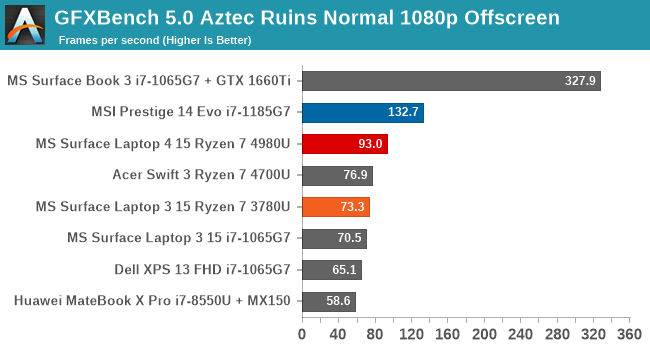
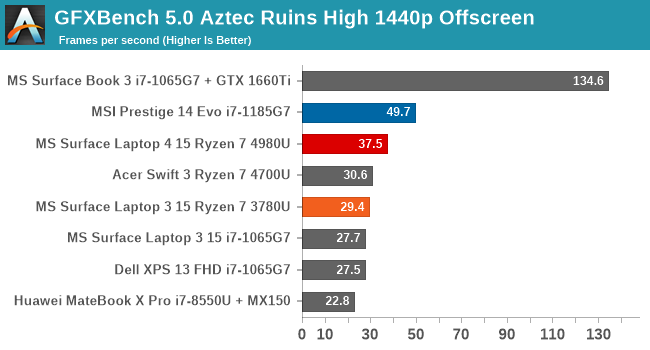
In the second synthetic test, we see a similar result. Although the Surface Laptop 4 with Ryzen is not able to surpass the 96 EU Intel Xe GPU in the MSI Prestige, it is still noticeably ahead of the other devices.
Tomb Raider

Although several years old now, the first of the rebooted Tomb Raider games can still be very demanding for internal graphics, especially with the resolution and details turned up. On lower settings, it is easily playable, with the Surface Laptop 4 just about hitting 120 FPS at our Value settings of 1366x768 Normal, but on 1920x1080 Ultra, the Surface Laptop 4 hits just 25 FPS average.
Rise of the Tomb Raider

The second installment of the rebooted Tomb Raider series added DirectX 12 support, and cranked up the graphics significantly. At the same Value settings as the previous game in the series, framerate drops to under 50 FPS average for the Surface Laptop 4, and it can’t quite match the Tiger Lake system which is on the cusp of 60 FPS average. This is a game we could not even realistically run on laptops from just a couple of years ago though, so on both the AMD and Intel side, integrated GPUs have come a long way.
Shadow of the Tomb Raider
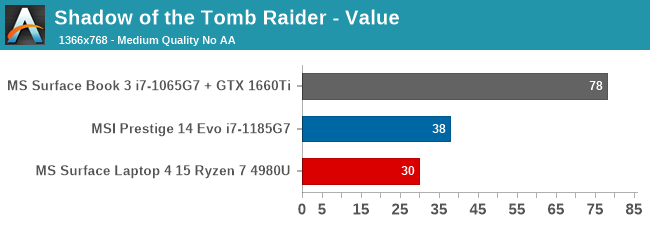
The latest installment in the Tomb Raider series is one we don’t even normally run on iGPU devices, as the results are unplayable, but to get a comparison, it was included this time. At 30 FPS average for the Surface Laptop 4, this is likely not going to be a great experience.
Strange Brigade
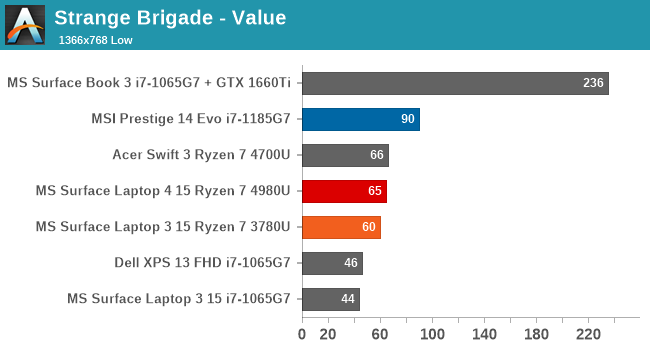
Another DirectX 12 title, Strange Brigade is not as demanding as some of the latest AAA titles, and as such, is definitely playable on devices with the latest integrated graphics. At 65 FPS, the game is 100% playable, but still well behind Tiger Lake.
F1 2019
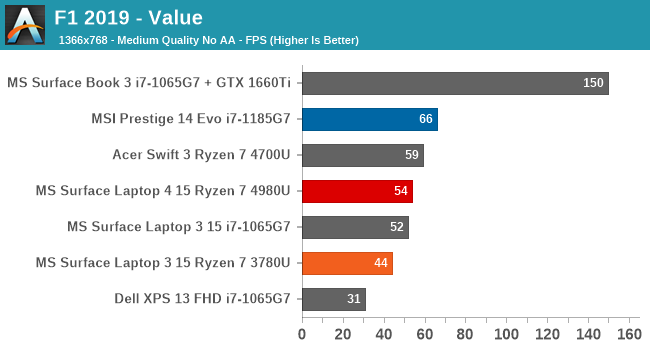
So far, the results have been quite clear, and although the gaps tighten up on F1 2019, as it is more CPU intensive than some of the previous games would have been, the Renoir APU still finds itself behind Tiger Lake.
Far Cry 5
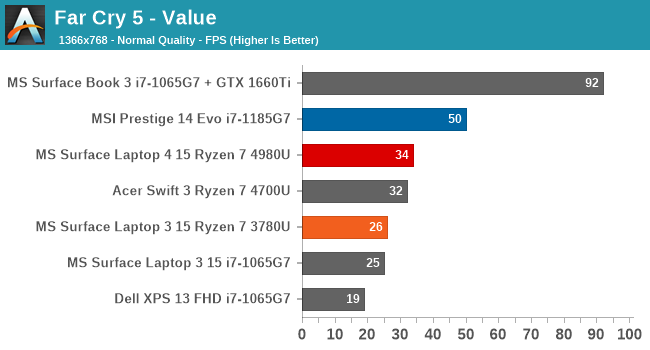
Far Cry is also a game that can be somewhat CPU limited, but not so much with these lower powered GPUs, and again, the pattern is the same as all of the other tests. What is interesting is how much better the Renoir system is than the previous Surface Laptop 3 with Picasso though. Moving down from 11 CUs down to 8 was easily overcome with the extra frequency headroom, and increased CPU throughput of the Renoir design. The latest AMD Cezanne APUs do not increase the GPU size either, so in theory, performance should be fairly similar to the Surface Laptop 4 on these titles.
GPU Conclusion
It is a bit of a let down to see that for this latest generation, Microsoft was not able to again add a larger GPU to the Ryzen 7, like they did for the Surface Laptop 3. The Ryzen 7 4980U is technically a semi-custom design, but really this only down to it being the best binned Renoir APUs that AMD is offering. Given AMD's history with graphics, it is a bit surprising to see Intel now leading on integrated graphics performance, especially after years of the UHD 620 and previous generation designs being quite low performance. AMD first made integrated graphics a priority with the original Ryzen APUs, adding in their Vega graphics architecture, and outclassing the competition in the process. But in this case, AMD has seemingly rested on its laurels, and with Tiger Lake, Intel has stolen this crown back. And, with AMD not adding any more graphics units with Cezanne, it is unlikely this will change.
The performance is good, and the extra frequency allowed on the 4980U does bump it ahead of the other Renoir devices we have tested, but AMD's integrated Vega GPU is definitely not the fastest iGPU anymore.










98 Comments
View All Comments
richardshannon77 - Monday, May 10, 2021 - link
I've been working at home for the past year using a grand total of 0 type-A ports on my laptop. I have a type-C connection to a type-C dock and a type-A BT dongle attached to that for my mouse. I suspect that this is along the lines of what the gods of technological advancement had in mind. At this point, it's type-C for the win. Although, I can't figure out where to put my 3.5" floppies :/saratoga4 - Thursday, May 6, 2021 - link
Perfectly fine to have 1 USB-C port, but since its used for charging there should be at least two other ports. Doesn't matter what they are, just give me the ability to have a thumb drive and mouse while charging.This is something the (much smaller) Dell XPS 13 devices do a lot better. My older model has charging, 2x USB and TB. They apparently had so much space left over they even threw in an SD card slot. A 15" laptop shouldn't have so much less.
s.yu - Sunday, May 9, 2021 - link
For a second I thought that was an iPP there. Turns out there's 1A, 1C and the headphone jack, that's bad but not unusable.Kevin G - Thursday, May 6, 2021 - link
I think you're looking at it backwards as computer manufacturers have learned one thing: consumers will continue to buy products they don't like if there are no alternatives at the prices they want. Consumers have given up fighting as pricing has become the dominant factor and people don't want to spend more, especially in a market whose pricing has been slowly creeping up of late.The reduction of the number of ports historically has made sense for the most part: USB has won out. However with Type-C that can also carry power, things do get more complicated as you can lose a data port for a peripheral when you need to charge the unit. Devices that only have two USB ports feel anemic in this regard as users do notice when they'll have to pull double duty in a crunch.
Alistair - Thursday, May 6, 2021 - link
Some of what you said makes sense. But removeable batteries and storage are next level, not USB port level priorities. Come On. Apple charges $800 for 1TB storage that I can buy for $100 to add to the Surface. Bam, I'm interested in the Surface. Because my phone lacks a removeable battery, I generally upgrade every 24 months as the phone won't last. Removeable batteries enable 3 and 4 year ownership. These are not "USB port" level myopia.Kamen Rider Blade - Friday, May 7, 2021 - link
The point is that Renoir offers more ports internally on it's SoC.1x USB 3.2 Gen1 Type-C
5x USB 3.2 Gen1 Type-A
2x USB 2.0 Type-A
That's what is natively available, why not implement all of those USB ports?
MS doesn't want to maximize the features or ports on Renoir, that's their choice.
But to the end user, it's cheapening out on features that are available on the SoC and not used.
grant3 - Tuesday, May 11, 2021 - link
Your guarantee is now broken: I would buy a surface laptop if they included a single additional thunderbolt port.You're probably right that -many- people do not care about ports, but that is changing quickly as people set up their work-from-home hardware and start to realize how damn vital having a hub to connect their monitors and other peripherals is.
Apple, Dell, and other makers got the memo years ago. They give their premium 15" laptops at least 3+ ports. Microsoft apparently thinks it can replicate Apple's "Remove features and raise the price" approach to hardware success, but haven't clued into the fact that it only works when they simultaneously offer -some- compelling alternative to the hardware they removed.
Eletriarnation - Thursday, May 6, 2021 - link
They could have rearranged the layout and added to the BoM cost to get in a second Type-A port which probably >95% of the user base won't ever need. Or, they could tell that <5% to buy a hub and deal with it.drothgery - Thursday, May 6, 2021 - link
Lots of people use external devices; I've got a TB3/USB-C dock that I connect my home or work laptop to that's chained to a monitor, keyboard, mouse, power, and wired internet.Pretty much no one uses optical media on laptops (or desktops, to be honest), which is why you have to use an external drive for it even on big clunky gaming laptops.
Calin - Friday, May 7, 2021 - link
The volume and weight of an optical disk for laptops compares to a 48Wh battery.You could easily fit one more 2.5 inch SATA SSD _and_ another 20Wh of battery inside that, or SSD plus one M2 plus on SODIMM, and so on.
Even if 17" gaming laptops are huge, their internal space is at a premium due to the cooling necessary for the CPU and GPU. In this case, the volume and weight of the optical drives give you another 20% cooling capacity.
One of my university colleagues had a computer (in a tower case) with a CD drive (650 MB) and a 420MB hard drive. Even if that would have been a laptop, losing so much volume to removable media larger than the hard drive would have been a win.
Not so much for the present - 9GB double side double density DVDs or 50GB BluRays do not compare well to even 256GB SSD of the low end devices.